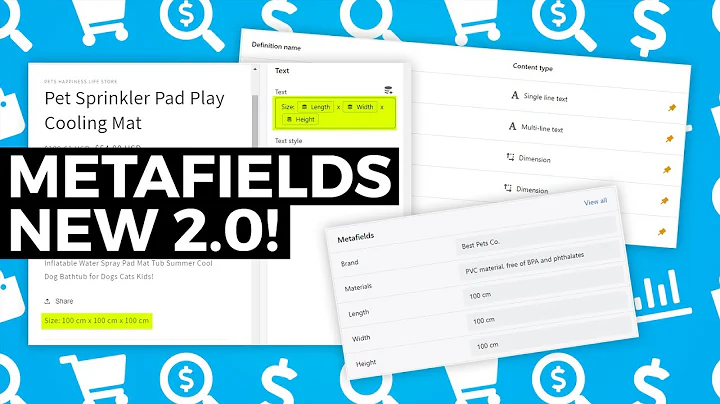Streamline Multi-Channel Fulfillment with ShipStation Automation
Table of Contents:
- Introduction
- Automating Shipstation for Multi-Channel Fulfillment
2.1 Setting up the Ship Out of FBA Rule
2.2 Handling Stocked out Items
2.3 Dealing with Slow FBA Shipping
- Integration with Other Platforms
3.1 Connecting Stores and Marketplaces
3.2 Recommended Marketplaces
- Launching on Walmart
4.1 Pricing Parity with Amazon
4.2 Using Different UPC Codes
4.3 Advertising Constraints
- FAQ
- Conclusion
Automating Shipstation: How to Use Multi-Channel Fulfillment with Ease
In the world of e-commerce, managing orders across different platforms can be a challenging task. But what if there was a way to automate the process and streamline your fulfillment operations? That's where Shipstation comes in. In this article, we will explore how to automate Shipstation to get your Etsy, Walmart, eBay orders, and more to come out of Amazon's FBA fulfillment program using a multi-channel fulfillment order.
1. Introduction
As an e-commerce seller, you know how important it is to efficiently manage your orders and ensure timely fulfillment. However, manually processing orders from different platforms can be time-consuming and prone to errors. That's where Shipstation comes in. Shipstation is a powerful automation solution that integrates with various e-commerce platforms, including Etsy, Walmart, eBay, and more. By connecting your stores and marketplaces to Shipstation, you can automate the fulfillment process and save valuable time.
2. Automating Shipstation for Multi-Channel Fulfillment
Managing orders from multiple platforms can be overwhelming, especially if you're using Amazon's FBA fulfillment program. However, with Shipstation, you can automate this process and centralize your order management. Let's dive into the steps involved in setting up Shipstation for multi-channel fulfillment.
2.1 Setting up the Ship Out of FBA Rule
The first step in automating Shipstation is to set up the "Ship out of FBA" rule. This rule is essential for ensuring that any order coming in from another channel can be fulfilled through FBA using a multi-channel fulfillment order. To set up this rule, follow these steps:
- Access Shipstation and go to the Rules section.
- Create a new rule and name it "Ship out of FBA".
- Make sure the rule is active and choose whether to apply it to every order or specific ones.
- Set the fulfillment provider as FBA in the drop-down menu.
- Select the shipping method (standard, expedited, or priority) based on your preferences.
- Check the "Automatic" checkbox to enable automatic fulfillment requests to the fulfillment provider.
Once you have set up this rule, any new order that meets the specified criteria will trigger the fulfillment process through FBA.
2.2 Handling Stocked out Items
In some cases, you may encounter stocked out items in FBA. When this happens, Shipstation will recognize the situation and put the order in the "Waiting Shipment" status. If you have communication with the customer and they are willing to wait for the item to arrive, you can ship it late without any issues. Shipstation will automatically trigger the fulfillment process back to Amazon once the item is ready and available.
2.3 Dealing with Slow FBA Shipping
It's not uncommon to experience delays in FBA shipping, especially during peak seasons or unforeseen circumstances like the current pandemic. In such situations, it's crucial to take appropriate action. If you notice that FBA is shipping slowly, consider filing tickets with Amazon to request reimbursement for late shipments. Remember, Amazon has its own requirements and should fulfill orders within the specified timeframe. By requesting reimbursements, you can recoup some of the costs incurred due to delays.
3. Integration with Other Platforms
To benefit from Shipstation's automation capabilities, you need to integrate it with your various e-commerce platforms. Shipstation offers seamless integration with popular platforms like eBay, Etsy, Walmart, and more. Let's explore how to connect your stores and marketplaces to Shipstation.
3.1 Connecting Stores and Marketplaces
Connecting your stores and marketplaces to Shipstation is a straightforward process. Here's a step-by-step guide:
- Log in to Shipstation and click on the gear icon in the top right corner.
- Select "Selling Channels" from the options.
- Choose the platform you want to connect, such as eBay, Amazon, Shopify, or Etsy.
- Follow the on-screen instructions to complete the integration.
By connecting your stores and marketplaces to Shipstation, you can consolidate all your orders in one central location and automate the fulfillment process.
3.2 Recommended Marketplaces
When it comes to selling on different platforms, choosing the right marketplaces can significantly impact your success. While there are numerous options available, some marketplaces stand out. Here are a few recommended marketplaces:
- Etsy: Known for its focus on handmade and unique products, Etsy provides a user-friendly platform for sellers. It offers ease of use and has a competitive referral fee structure.
- Walmart: Although still developing, Walmart has the potential to challenge Amazon's dominance. Launching on Walmart can diversify your sales channels and expand your reach to a broader customer base.
- eBay: As one of the oldest and most popular marketplaces, eBay offers a wide range of products. With eBay, you have the option to advertise your products with a cost-per-acquisition model, ensuring you pay only for successful orders.
Launching on multiple platforms can help you reach a larger audience and increase your sales potential. However, it's essential to understand the constraints and requirements of each platform before diving in.
4. Launching on Walmart
Walmart is a growing marketplace that offers tremendous opportunities for sellers. While launching on Walmart can be lucrative, there are a few considerations to keep in mind. Let's explore how to make the most out of your Walmart presence.
4.1 Pricing Parity with Amazon
When selling on Walmart, it's crucial to maintain pricing parity with Amazon. If you offer a lower price on Walmart than on Amazon, it may result in Amazon suppressing your buy box. To avoid this issue, consider raising your prices on Walmart a couple of days before raising them on Amazon. By keeping your prices in parity, you can ensure a smooth selling experience.
4.2 Using Different UPC Codes
In some cases, using different UPC codes on different platforms can help mitigate pricing and inventory conflicts. While this may go against the guidelines, sellers have found this workaround to be effective. However, it's essential to note that using different UPC codes may not be ideal for all situations.
4.3 Advertising Constraints
Advertising on Walmart comes with certain constraints. You need to spend at least $1,000 per month to advertise on the platform. Although this may seem intimidating, advertising on Walmart can significantly boost your visibility and sales potential.
While Walmart still has room for improvement, it represents an excellent opportunity to diversify your sales channels and reduce your reliance on Amazon.
5. FAQ
Here are some frequently asked questions about automating Shipstation and multi-channel fulfillment:
Q: How much does it cost to set up Shipstation for Walmart, eBay, and Etsy?
A: The cost for setting up Shipstation varies depending on the marketplace. For Walmart, the recommended budget is $1,000. For eBay and Etsy, the cost is $800 each. If you have other marketplaces in mind, feel free to reach out for customized pricing.
Q: Can I connect multiple stores and marketplaces to Shipstation?
A: Yes, Shipstation allows you to connect multiple stores and marketplaces. This feature enables you to centralize your order management and streamline the fulfillment process.
Q: Is it necessary to maintain pricing parity on all platforms?
A: While it's not mandatory, maintaining pricing parity with Amazon on other platforms like Walmart can help you avoid complications such as buy box suppression.
Q: Can I use different UPC codes on different platforms?
A: Using different UPC codes on different platforms can be a workaround for pricing and inventory conflicts. However, it's essential to consider the guidelines and potential consequences before opting for this approach.
Q: What are the recommended marketplaces to sell on?
A: The recommended marketplaces to sell on include Etsy, Walmart, eBay, and Amazon. These platforms offer diverse customer bases and various selling opportunities.
6. Conclusion
Automating Shipstation for multi-channel fulfillment is a game-changer for e-commerce sellers. By setting up Shipstation correctly and integrating it with various platforms, you can streamline your order management and save valuable time. Whether you're selling on Walmart, eBay, Etsy, or other marketplaces, Shipstation's automation capabilities offer tremendous benefits. Take advantage of this powerful tool to enhance your fulfillment operations and grow your business.






















